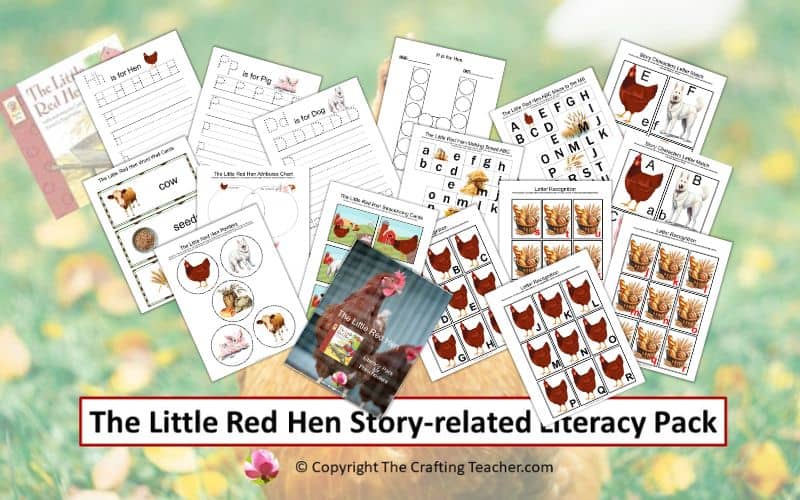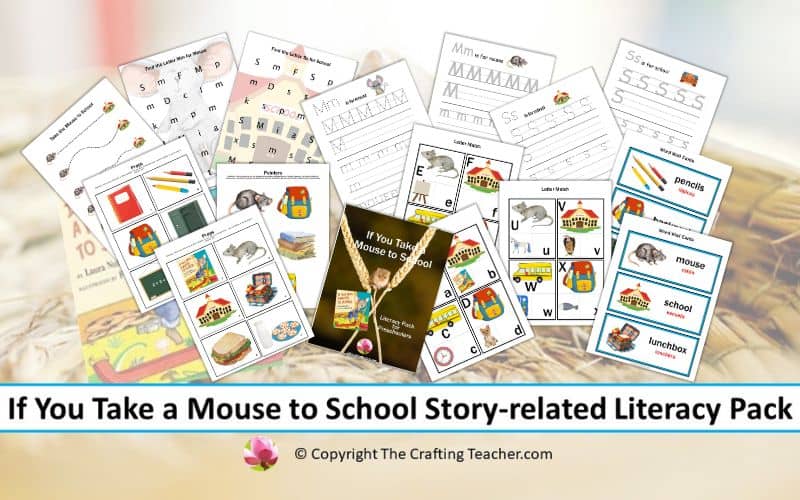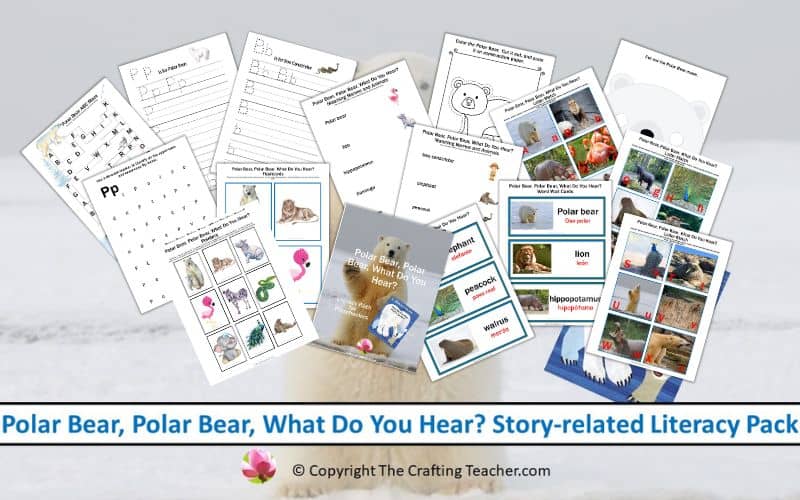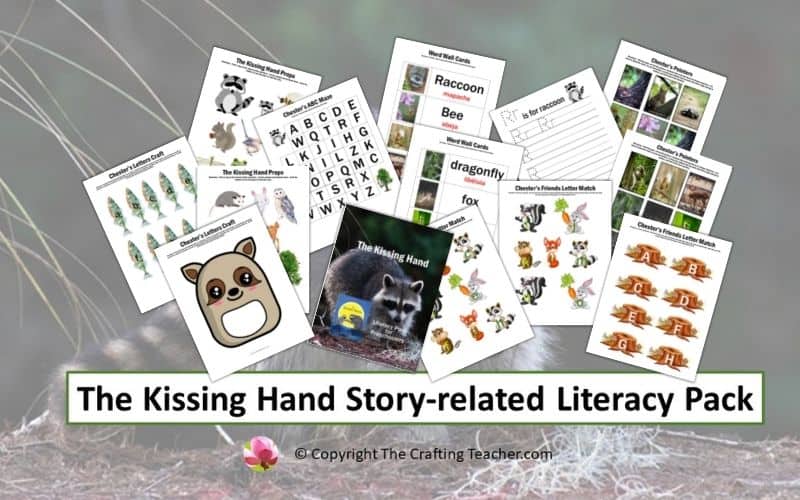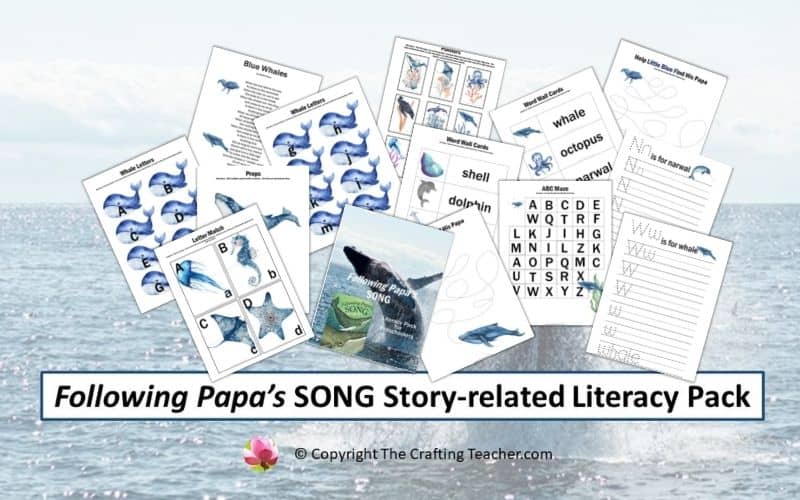The Little Red Hen Story-related Literacy Pack for Preschoolers
Affiliate Disclosure: “This post contains affiliate links, which means I receive a small commission, at no extra cost to you, if you make a purchase using those links.”
The Little Red Hen is a classic story with a predictable text structure, a critical feature that makes it an ideal choice for early literacy development. The version I am using today, retold by Carol Ottolenghi, narrates the story of a little red hen who discovers wheat seeds and decides to plant them to make bread. She seeks help from the dog, the pig, and the cow, but they all refuse. In the end, her animal friends, who initially declined to help, want to share the bread she made, but since no one assisted her, she enjoys the bread all by herself.
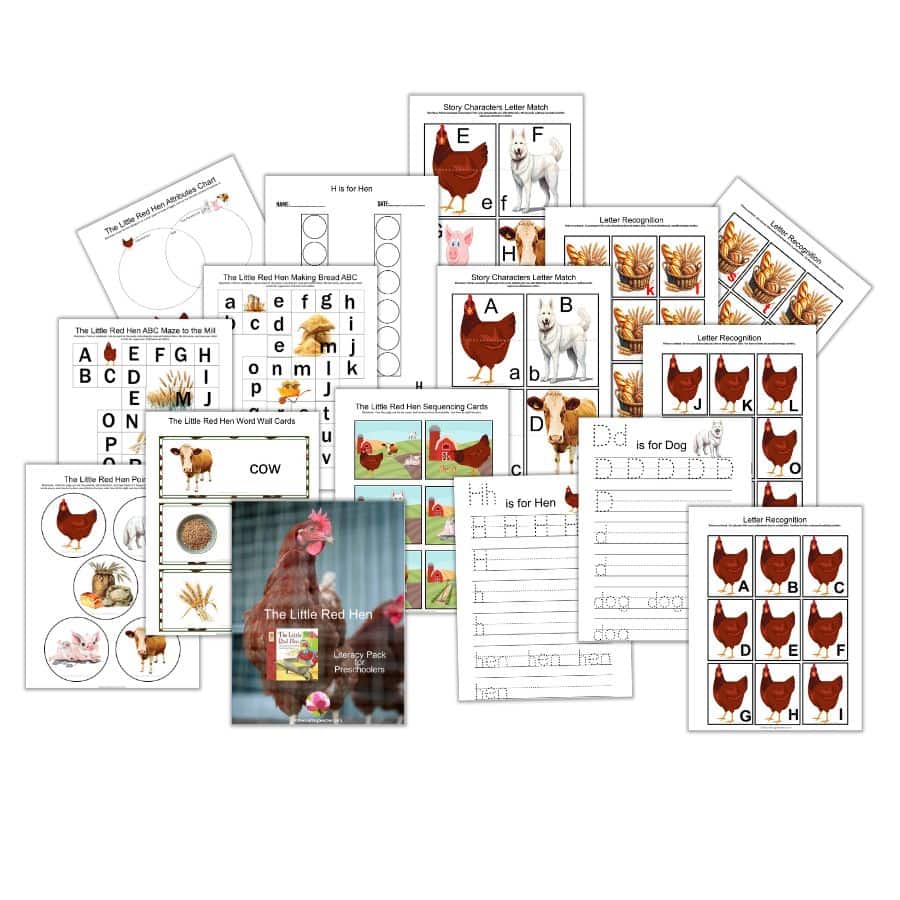
I have created a FREE 40-page The Little Red Hen Literacy Pack with nine activity sets to accompany this book. You can download it at the end of this post.
The Little Red Hen Literacy Pack
The Little Red Hen Literacy Pack is a comprehensive resource that effectively reinforces preschoolers’ literacy skills and vocabulary development. It is designed to be used with the story, providing activities that solidify students’ learning and enhance their understanding of the text by engaging them in hands-on learning experiences.
Developing literacy skills includes awareness of books and prints, knowing the relationships between letters and sounds that make up words, vocabulary development, and understanding stories. If a child cannot read, it will be impossible for him or her to learn important concepts such as Math and Science and understand the world around him or her.
Before starting the activities, gather some real wheat stalks, seeds, and wheat products, especially bread or pictures. These items will help the children understand how wheat grains eventually become bread. You can use them to explain the process more tangibly.
Start by engaging your preschoolers with the book’s illustrations. Please encourage them to share their thoughts and observations. Explain that you will read a story about The Little Red Hen and her friends, then read the story, fostering a dynamic learning environment. The interactive nature of these activities will keep the children engaged and excited about learning.
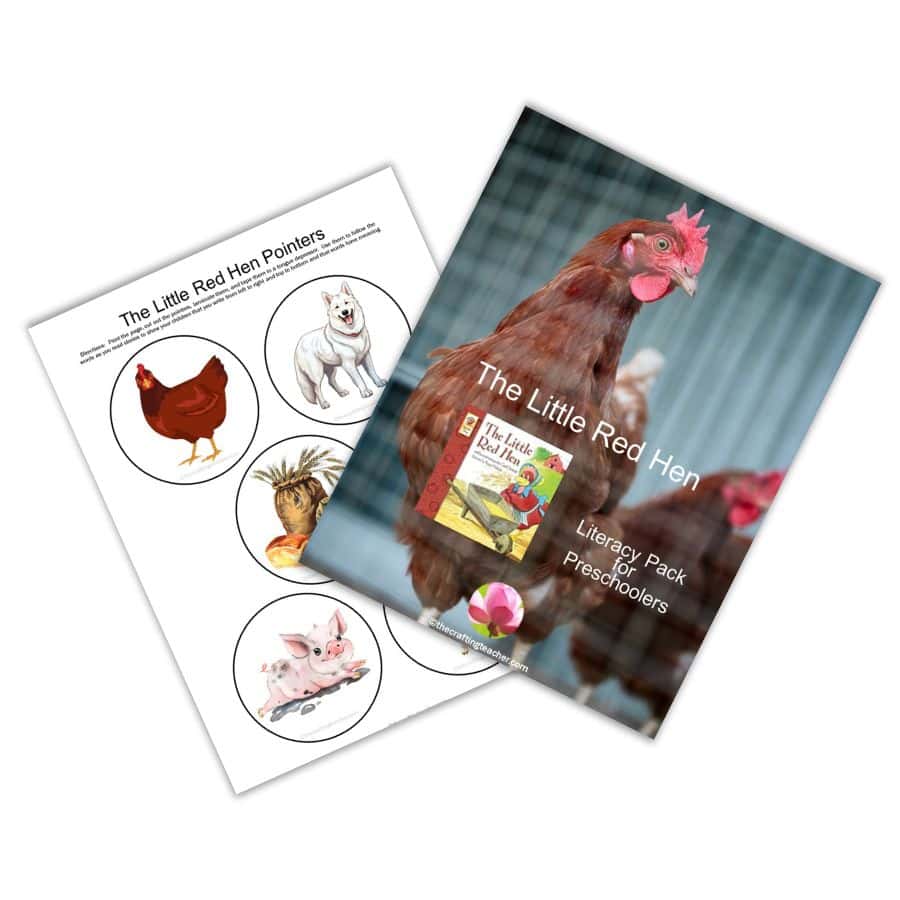
When reading, I find it beneficial to use pointers to guide the preschoolers’ eyes across the page. This simple technique reinforces the concept of reading from left to right and top to bottom, as well as the meaning of words.
In the literacy pack for this book, I included four pointers featuring the hen, the dog, the pig, and the cow. To use them, print them on white cardstock, laminate them, and glue them to a tongue depressor.
Questions About The Story
Before reading The Little Red Hen story, review the parts of the book: the cover, title, author, illustrator, spine, and back. Read the story aloud. Be sure to read the book more than once.
During reading, ask who, what, where, when, and why questions, such as:
- Who are the main characters of the story?
- Where is the story taking place?
- When do you think it is better to plant?
Also, open-ended questions, such as those about the student’s life experiences, can be asked, and there can be multiple answers.
After reading questions about the story, such as:
- Do you think animals can plant seeds and make bread?
- What do you think is the message of the story?
- Do you think this story is real or make-believe? Why? Why not?
- Do you think the little red hen was mean because she didn’t share her bread with the animals that didn’t help her make it?
- What do you think friends should do?
Retelling the Story
Gather the children in a circle on the floor or around a table. Retelling the story can help preschoolers understand what happened first, then, next, last, etc. Pulling out sequencing cards is especially helpful for teaching cause-and-effect concepts and helping them understand what is happening in the story.
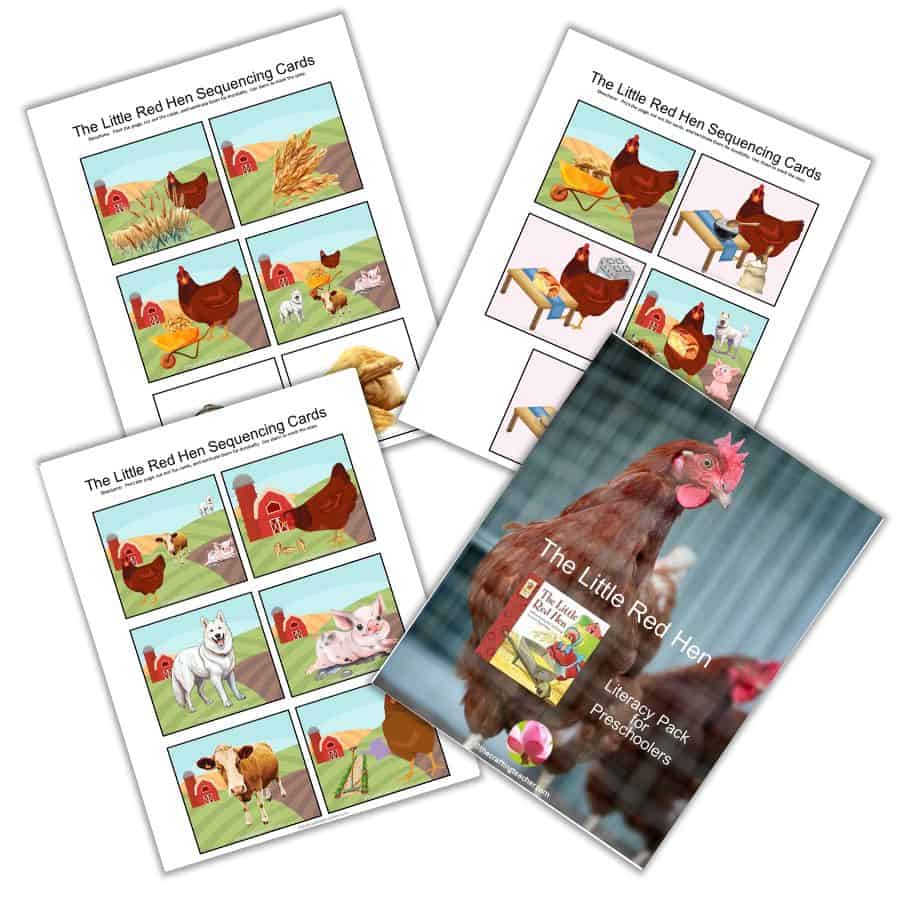
Distribute the story sequencing cards provided in the pack among the children and encourage them to retell the story using them. They should place the cards on the floor, board, or table to retell the story. When the activity is complete, place the sequencing cards in the Listening or Library Center to invite the children to retell the story independently.
Oral Language and Vocabulary Development
I like to use a word wall because it is a vital literacy tool that helps your children learn the alphabet, letter sounds, and words related to the theme you use that week or month.
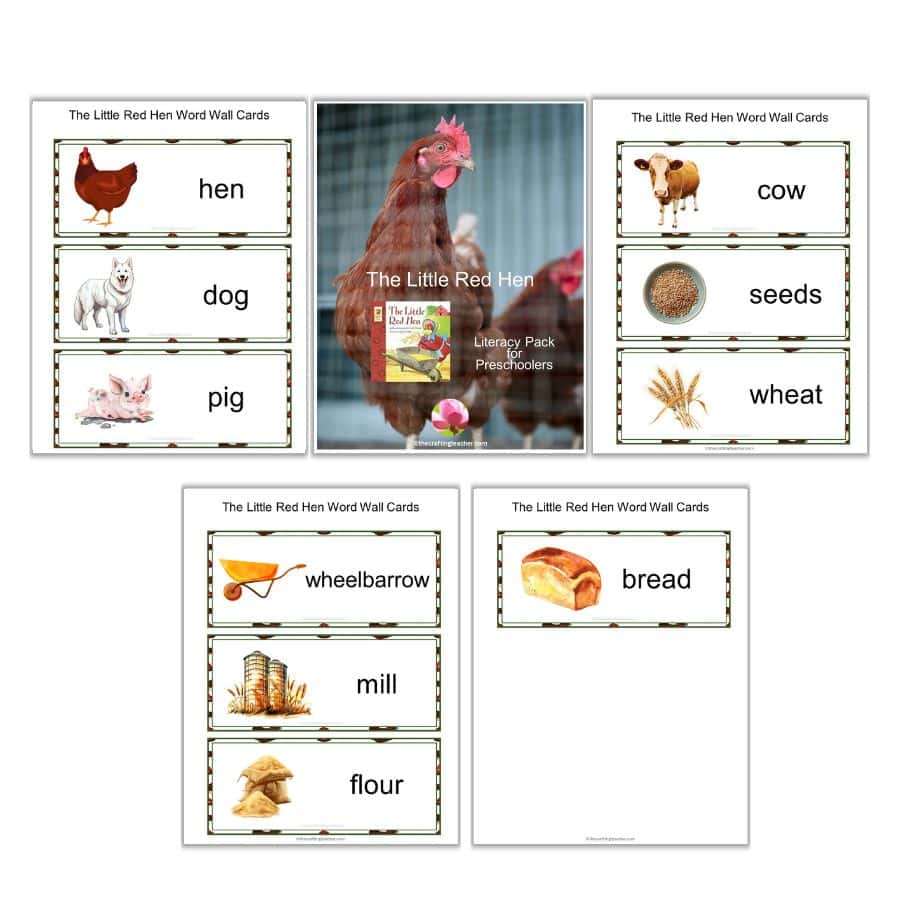
I included the words hen, dog, pig, cow, seeds, wheat, wheelbarrow, mill, flour, and bread in the pack. Print them on white cardstock and laminate for durability. Add the words to your Word Wall to help your students learn to read and spell.
Remind your students words are made up of individual letters. These word wall cards can be used as a reference to plan different pre-reading activities for your students. For example:
- Learn or review the name and sound of the beginning letter of each word.
- Clap the syllables on each word.
- Spell some words.
- Find other words that start with the same beginning letter.
- Identify words that start with the same beginning sound.
- Use the words in a short sentence.
Tracing Letters and Words
The Little Red Hen literacy pack includes nine letter sheets: Hh is for Hen, Dd is for Dog, Pp is for Pig, Cc is for Cow, Ss is for Seeds, Ww is for Wheat, Mm is for Mill, Ff is for Flour, and Bb is for Bread.
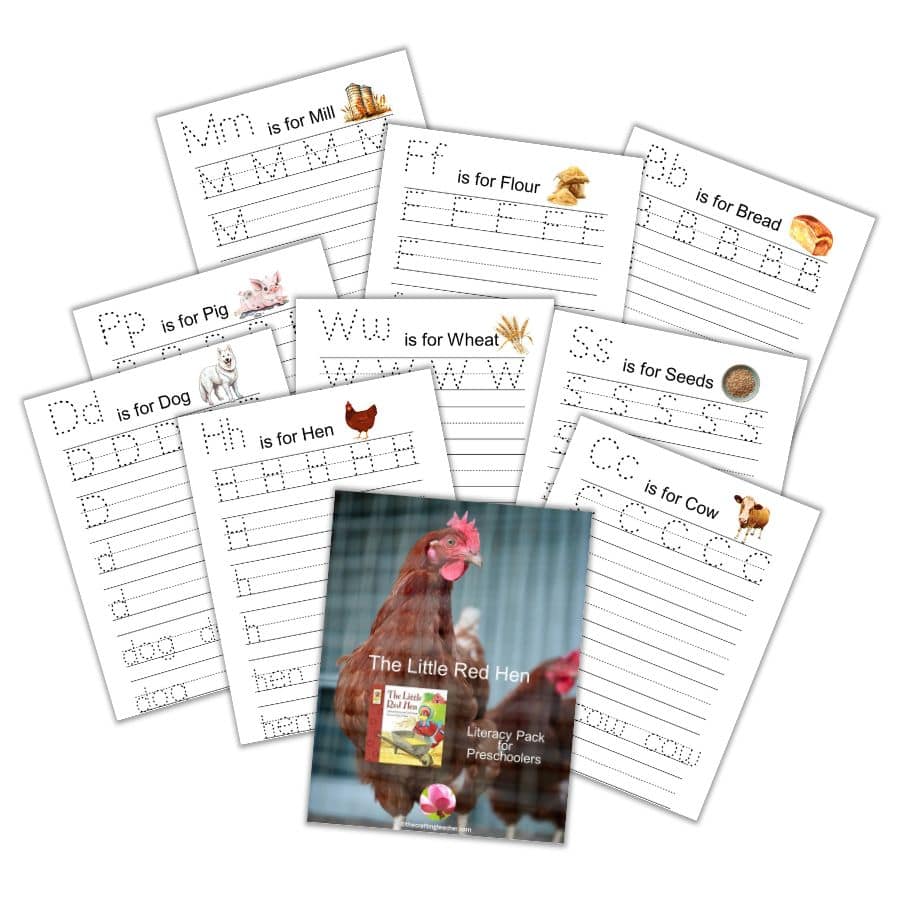
Print each page on white cardstock and laminate, or place it in a dry-erase pocket to make it last longer and be used multiple times. Invite the children to trace the letters using a dry-erase marker.
This activity dramatically strengthens the children’s language, letter recognition, pre-writing, and fine motor skills. To extend the activity, you can use them to:
- Use a dry-erase marker to trace the letters and words.
- Copy the words with a pencil, crayon, or marker.
- Match each letter and word with magnetic, wooden, or foam letters.
- Copy the letters and words with playdough.
The Little Red Hen Letter Recognition
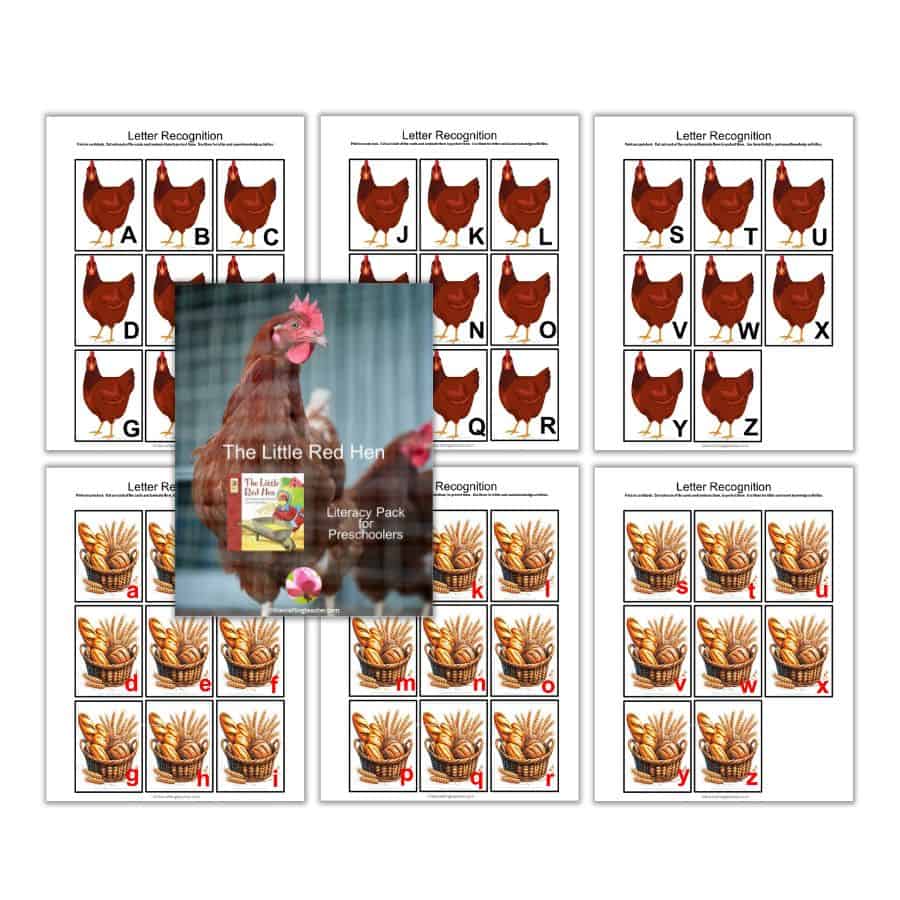
To prepare for this activity, print the pages on white cardstock, cut out the cards, and laminate them for durability. You can have the children work alone or in pairs to match The Little Red Hen uppercase letters with the bread basket lowercase letters. Use all or part of the letters according to your children’s developmental stage.
Story Characters Letter Match
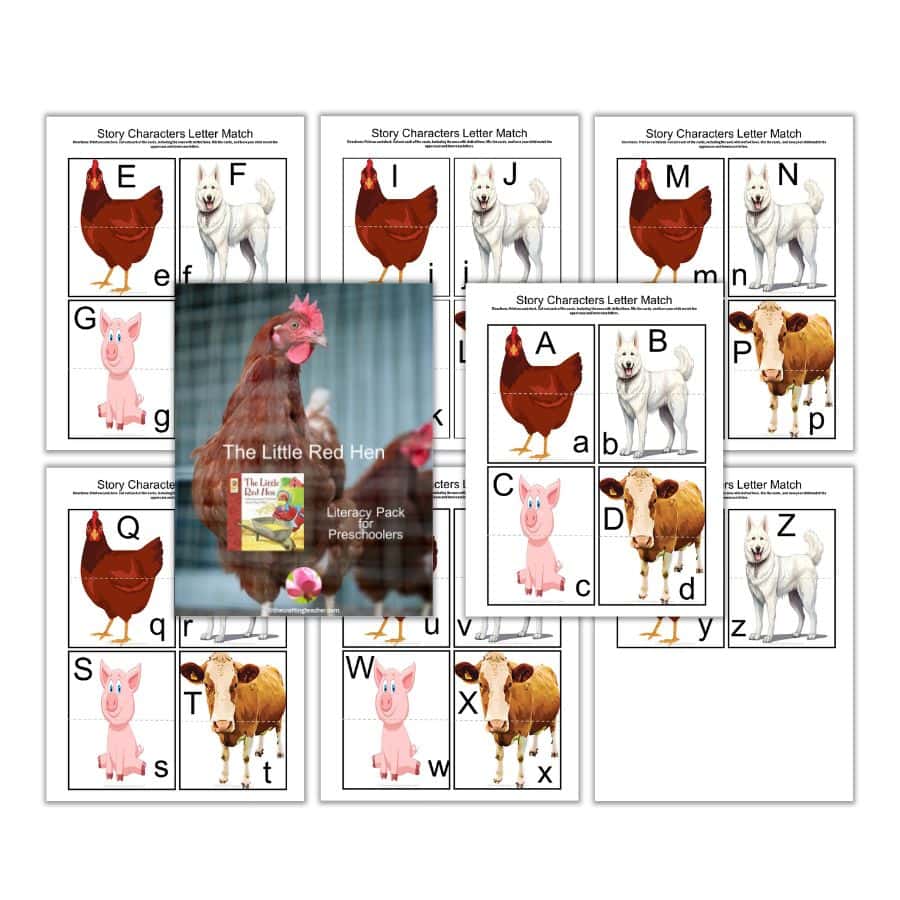
Print the pages on white cardstock, cut out the cards, and laminate them for durability. Present the letter match cards, and have your children match the upper-case and lower-case letters. Invite them to say the name and sound of the letter they match.
The Little Red Hen ABC Mazes

I’ve included two ABC mazes on The Little Red Hen pack, one with uppercase letters and another with lowercase letters. Have the children review the alphabet in order using a dot-to-dot marker to mark each letter correctly. If you want to use the activity multiple times, print the pages in white cardstock and laminate them or place them in a dry-erase pocket, and have your children use small manipulatives such as bingo chips, mini erasers, buttons, pom-poms, or bread and hen mini toys to mark the alphabet letters. Please encourage them to say the names of the letters as they go.
The Little Red Hen Attributes Chart
A visual chart is a very effective way to help children see similarities and differences. In this case, a Venn Diagram is an effective tool.
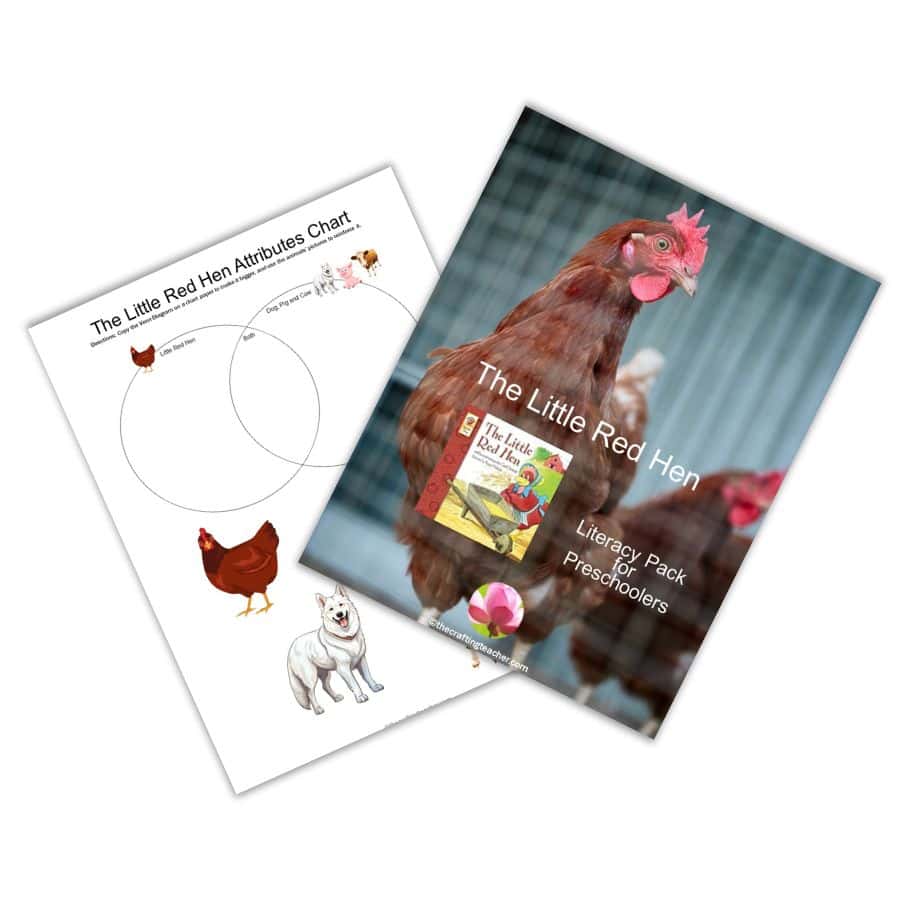
You can trace a large Venn Diagram on chart paper and use the pictures in the pack to reinforce the areas. After reading The Little Red Hen story, please talk about the similarities and differences using the words and images in the text to show them how they can find the answers. Once you discuss it, place their comments on the correct chart location. After completion, you can use the review of what they said or verify if they change their perceptions as they hear the story again.
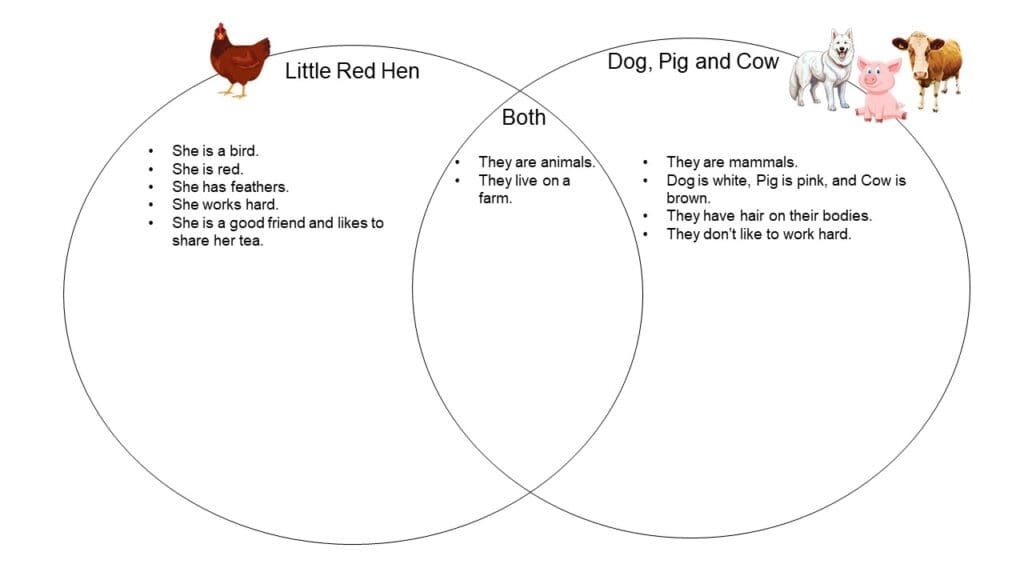
Tracing Dot-Dot Letters
- Letter Identification – children learn to identify letters represented in different ways.
- Fine motor skills development – they learn to grip a pencil, which helps them develop pencil control.
- Pre-writing skills – they learn to put pressure on the paper with the markers and create a circular print on their paper.
- Spatial awareness – they develop an understanding of each letter’s size, direction, and orientation.
- Concentration – they learn to focus on what they are doing.

Print one page for each letter on regular paper, and provide dot-to-dot markers for them to fill out the circles.
Write a Class Story to Make a Book
During circle time, invite your children to create a story, reminding them it must have a beginning, middle, and end. Use chart paper to take dictation.
You can encourage them by starting with “If I were a little red hen….” or “If I could live on a farm…” Print the story and have the students illustrate it when it is finished. Then, put it together as a book for the library and make a copy for each author.
Sing Songs
Singing is an excellent literacy activity; we all know children love it. I found a cute song for The Little Red Hen story on mrsjonesroom.com that you can print and use.
The Little Red Hen Song (Tune: Mulberry Bush)
This is the way I plant the seed,
Plant the seed, plant the seed,
This is the way I plant the seed,
So early in the morning.
This is the way I cut the wheat,
Cut the wheat, cut the wheat,
This is the way I cut the wheat,
So early in the morning.
This is the way I go to the mill,
Go to the mill, go to the mill,
This is the way I go to the mill,
So early in the morning.
This is the way I make the dough,
Make the dough, make the dough,
This is the way I make the dough,
So early in the morning.
This is the way I bake the bread,
Bake the bread, bake the bread,
This is the way I bake the bread,
So early in the morning.
This is the way I eat the bread,
Eat the bread, eat the bread,
This is the way I eat the bread,
So early in the morning.
The Little Red Hen Related Books
You can always read and add other versions of The Little Red Hen and related books to your library at different centers to give children a comprehensive learning experience and variety.
These books can be found at your local library, used book store, or on Amazon. To add them to your collection, you can use my affiliate links embedded in the titles for immediate access.
- The Little Red Hen by Byron Barton.
- The Little Red Hen by Jerry Pinkey.
- The Little Red Hen by Paul Galdone.
- The Little Red Hen by Little Golden Books.
- The Hen Who Sailed Around the World: A True Story by Guirec Soudee
- Henrietta, the Hen Who Wouldn’t Come In by J B Allen.
- Hattie Peck by Emma Levey.
- What is Love, Mommy Hen? by Kate Kos.
- Chicken Coop Chaos by Nancy Tavares.
- Gwen the Rescue Hen by Leslie Crawford.
Pin It For Later
If you are in a rush and don’t have time to read the post and download the printable but want to save it for later, pin this to your Literacy board on Pinterest.
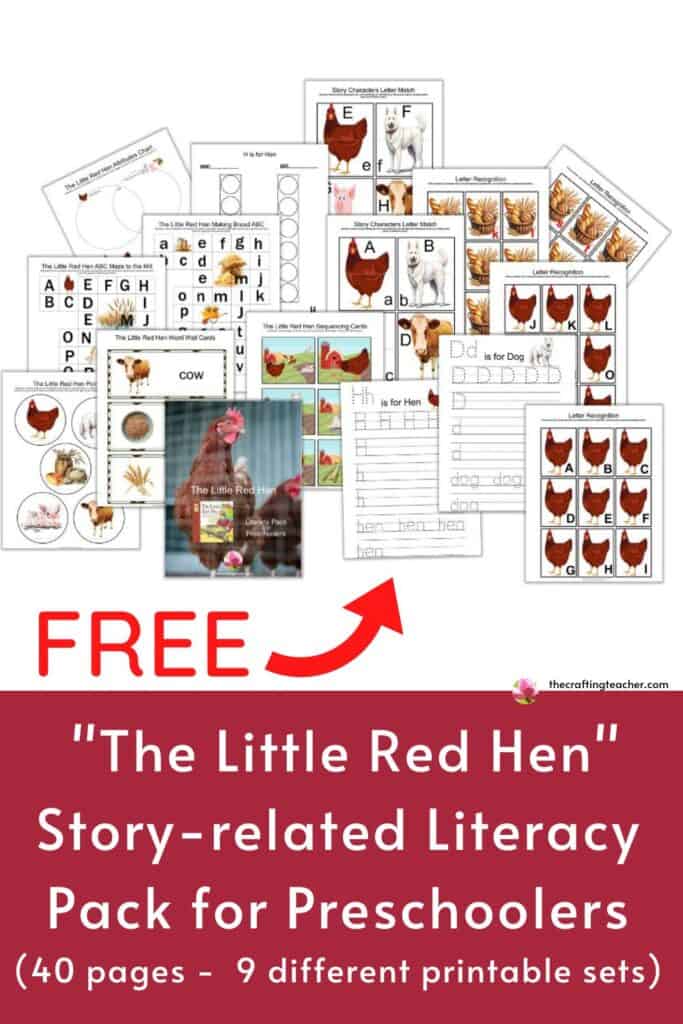
You can use this pack alone or in combination with the activities I offer in The Little Red Hen Math Pack, which are also free, to tie these domains together for a complete educational process.
Don’t forget to download your FREE The Little Red Hen Literacy pack. You have to click on the link below and type your email for an immediate download.
Be happy, safe, and creative. I wish you well.
Love,

P.S. Let me know if these activities work for you, and if you want to see an article or a printable about how to make something specific, please let me know, and I will try my best to create it for you.

